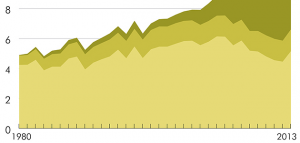Financial advisors and service professionals are constantly looking for ways to market their solutions and bring in more customers.
However, the traditional marketing methods can become costly and have varying results, not all of which are positive.
Inbound marketing provides a great new avenue for financial services looking to refresh their marketing approach.
With a customer-focused strategy and digital techniques, inbound marketing can help those in the financial industry connect with customers and improve their conversion rates.
- But what exactly is inbound marketing, and why is inbound marketing for financial services important?
- And is it really a better solution for the financial industry than traditional outbound marketing?
In this article, we’ll answer those questions and take a look at 11 different inbound marketing strategies that you should start implementing today.
- What is Inbound Marketing?
- Why Is Inbound Marketing for Financial Services and Industries Important?
- Inbound or Outbound? Which Matters More?
- 11 Inbound Marketing Strategies that Benefit Financial Companies
- Wrap Up: Trying Inbound Marketing for Financial Services
What is Inbound Marketing?
Inbound marketing is a marketing strategy that attracts audiences to your brand, products, and services.
It takes advantage of the huge number of customers who spend their time online and it helps to solve questions in their customer journey while guiding them towards a purchase.
Because inbound is a strategy meant to create personalized experiences rather than mass outreach, it requires time and dedication from marketing teams, while outbound marketing tends to be a one-size-fits-all solution.
Inbound uses different forms of content, to deliver a message to prospects wherever they may be online. Types of content include:
- Websites
- Blogs
- Videos
- Guidebooks
- eBooks
- Whitepapers
- Infographics
- Social Posts
- Product Comparisons
- Reviews and Testimonials
By putting these forms of content online, inbound marketing delivers your brand’s message to those who are actively searching for your products, services, and solutions.
That means that more of your leads will be qualified and interested in making a purchase, improving your ROI and customer conversion rates.
Inbound works particularly well in today’s world, where customers want to do their own research before purchasing a product and don’t want to engage with invasive messaging or mass marketing.
It helps them feel in control of their purchase journey by giving them the right information they need at the right time when they are looking for it.
Why Is Inbound Marketing for Financial Services and Industries Important?
Inbound marketing focuses on creating connections with customers and delivering them the best, personalized experience as they consider making a purchase or becoming a client of your company.
Most potential clients spend their time doing extensive online research before ever reaching out to a company, meaning that inbound marketing and digital tactics are the best way to reach your prospects.
In a field like financial services especially, customers want to know they are making the right decision before partnering with a business.
A strong inbound marketing strategy helps to guide the customer to your services rather than competitors.
Because inbound is a newer marketing approach than traditional outbound methods, there can sometimes be a pushback from businesses who are used to doing things a certain way, or who worry that their industry isn’t suited for digital marketing.
However, the opposite is true.
Inbound marketing works for every industry
And it works by putting the customer as the focal point of every marketing activity.
As customers begin to spend more of their time online, they lose interest in older marketing methods like direct mail or radio ads, and instead want to feel as though the businesses they research are up-to-date and forward-looking.
The financial services industry is one that is based around relationships, provable depth of knowledge, and ongoing communication between advisor and client.
All of these core values fit directly into the goals of an inbound marketing strategy, making it a perfect solution for your business’s marketing needs.
Inbound or Outbound? Which Matters More?
While inbound marketing is an incredibly beneficial strategy for financial service industries, there are many businesses and individuals who cling to traditional, otherwise known as outbound, marketing strategies instead.
Outbound marketing is a strategy that sends out a message to a mass group in the thought that the wider the audience that receives a message the larger the potential return.
Typical outbound marketing activities include:
- Direct Mail
- In-Person Events
- Newspaper Ads
- Radio Ads
- Television Commercials
- Cold Calling
- Billboards
- Mass (Spam) Emails
While these traditional methods are losing popularity, they can be good for things like raising brand awareness or reaching specific audiences who tend to avoid technology.
On the whole, an outbound marketing strategy can be very costly with little control over the outcomes of ROI.
Often the message of an outbound marketing campaign is put in front of customers who aren’t looking for the advertised product or service.
Inbound marketing, on the other hand, focuses on customers who are actively searching or looking for your specific products and services, meaning that they are more likely to buy from your company as your marketing efforts reach their purchasing priorities at the right time.
Why don’t use both?
Yes, most businesses will have a multi-faceted marketing strategy that uses both elements of inbound and outbound.
But the truth is that most brands are making the move towards inbound marketing for a reason.
Inbound reaches customers where they are — online — and is easily quantifiable with the help of tools and software applications.
Financial institutions and other financial service professionals are likely to use outbound methods as finance is a more traditional industry.
However, it is highly recommended that inbound marketing becomes a major part of your overall marketing approach.
Without it, you risk being left behind while your competitors move forward.
11 Inbound Marketing Strategies that Benefit Financial Companies
Now that you understand the value that inbound marketing and digital marketing techniques can bring to your business, let’s take a look at a few different strategies that you can apply in your approach.
These 11 examples provide a wide range of strategies that cover many different aspects of inbound marketing for financial services.
1. Include Paid Advertisements
Paid advertisements on Google or social media sites can help to bridge the gap between traditional, outbound advertising and digital marketing.
While these are still advertisements that aren’t the result of an organic search, online ad platforms have created filters that help you narrow down the audience which sees the advertisements based on demographics and other important identifying information.
This helps ensure that your ads are in front of a target audience, not a wide audience like a radio or television ad.
You can also create ads based on keywords or search phrases, which helps you again ensure that the people who see your advertisements are actively searching for terms related to your services.
2. Keep on Top of Messages
A big part of inbound marketing is letting customers come to you through social media, chatbots, online forms, emails, or other non-evasive messages.
However, this still means that you are required to spend your time responding to and nurturing prospective clients.
Being a prompt messenger and making sure that you invest time in engaging with your audience is an important step in creating an online presence and building a successful inbound marketing program.
There are tools that can help you track messages, so you don’t have to worry about an opportunity slipping through your fingers.
3. Start Content Marketing
Content marketing is based around different content forms like blogs or eBooks, and is a cornerstone of your inbound marketing strategy.
After all, how will leads be able to find information about your services if you don’t publish any of that information?
Content marketing requires some setup before you can launch.
You’ll want to spend time picking out topic clusters related to your services and doing keyword research in order to narrow down the exact terms you want your pages to rank for on search engines.
4. Send Inbound Emails
Emailing is a great way to stay in contact with your prospects once you’ve collected their names and information through content marketing and other inbound strategies.
You want to send short, easy-to-read emails that have a clear call-to-action. You’ll also want to keep track of how often you send out emails.
If you’re in a prospective client’s inbox too often, they may think of you as spam. If you aren’t in there enough, they might forget you.
Creating automated drip campaigns that automatically send out emails on a semi-regular basis is a great way to be consistent.
5. Incorporate Storytelling Elements
Everyone likes a good story, including your clients.
When you incorporate storytelling elements into your content, you have a higher chance of capturing the attention of readers.
Storytelling doesn’t mean writing a fairytale, but it can include things like setting your readers up as a hero who comes across a common problem which your company can solve.
These simple content elements create a story that customers want to be a part of.
6. Qualify Your Leads and Prospects
Once your inbound marketing strategy roles out, you might be surprised at the number of leads you have coming in.
Creating a system of qualifying your leads is a great way to make sure that you spend your time marketing and selling to leads who will become clients.
Not only does lead qualifying help you avoid wasting time, but it can help you determine which of your particular services a prospective client is interested in, so you can then direct them to the appropriate salesperson or financial advisor.
7. Focus on Quality, Not Quantity
Far too often, when implementing an inbound marketing strategy, brands focus more on the quantity of content rather than the quality.
In truth, the quality is much more important than the amount of content you have available.
While you do want to cover all relevant topics and keywords, if your content is too short, doesn’t answer questions, or is poorly written, the search algorithms will view your website as untrustworthy and won’t rank your content high enough to be seen by clients.
8. Use Data to Drive Decisions
One of the biggest benefits your company receives from inbound marketing is the amount of data and information you gather on your prospects and clients.
Data from your social media platforms and marketing tools will help you learn how your efforts are performing.
In addition to performance data, you can learn critical areas for improvement in your customer’s journeys.
For example, if you get a high view count on a blog post but lack any follow-through, you know that your call-to-actions needs to be stronger or more visible.
9. Automate Marketing Tasks
Marketing software isn’t just about compiling data and providing performance stats. It can also help you automate time-consuming and repetitive marketing tasks.
Automations can help you:
- Send out emails on a regular basis.
- Create a workflow to direct incoming web traffic.
- Add personalization tokens like first names, last names, or business names to content.
- Segment your audience and contact database.
- Qualify and organize your leads.
- Test different elements to measure performance.
- Set reminders for message responses or follow-ups.
10. Regulate Social Media Posting
Regular social media postings are important to create consistency and deliver regular messages to your audience on the platforms they visit most.
It’s a great place to publish information about your company or offer promotions, as your followers will be able to see it without interrupting their own buyer’s experience.
11. Study Reports to Inform Next Steps
Reporting and analytics are key to creating the right next steps in your inbound marketing program.
Using the auto-generated reports from your marketing tool can help your businesses get the most out of your marketing efforts and make relevant updates to your strategies to continue to grow your business.
Wrap Up: Trying Inbound Marketing for Financial Services
Inbound marketing for financial services doesn’t have to be overly complicated.
At its core, inbound marketing puts the customer experience first and allows businesses to have better control and visibility into their marketing performance.
While outbound tactics might still be popular choices in industries like the financial sector, expanding into inbound marketing can bring around many different benefits.
And the strategies that you should implement can be made by any person who wants to improve their business revenue and company performance.
Performance tracking, however, can be difficult without the right tools.
Our marketing and sales performance tracker helps you understand if you’ve met business goals and simplifies the ways you measure the success of your marketing and sales initiatives.
Download our free performance tracker sheet and easily organize your metrics today!










